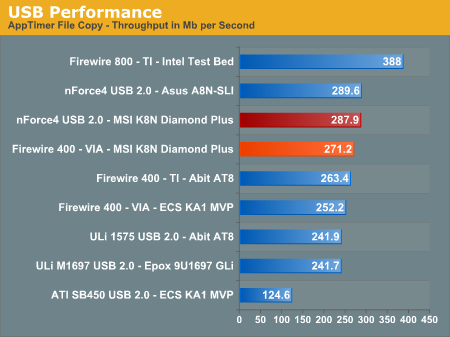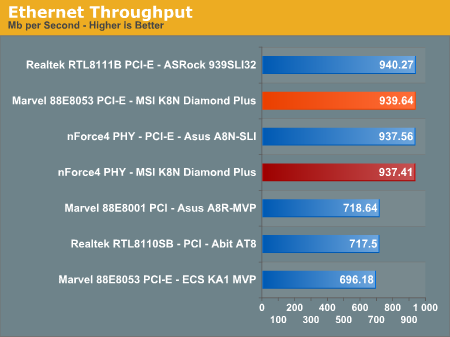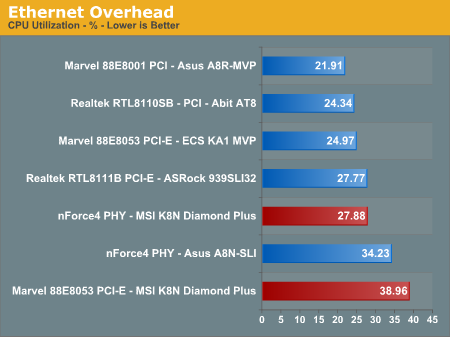Firewire and USB
After looking at many options for Firewire and USB testing, we finally determined that an external USB 2.0, Firewire 400, and Firewire 800 hard disk would be a sensible way to look at USB and Firewire throughput. We utilize a RAM disk as our "server", since memory removes almost all overhead from the serving end. We turn off disk caching on the USB and Firewire side by setting up the drives for "quick disconnect" so our results are consistent.
We use 1GB of fast 2-2-2-5 system memory set up as a 450MB RAM disk and 550MB of system memory. Our standard file is the SPECviewPerf install file, which measures 432,533,504 bytes (412.4961MB). After copying this file to our RAM disk, we measured the time for writing from the RAM disk to our external USB 2.0, Firewire 400, or Firewire 800 drive utilizing our internal Windows based timing program. The copy times in seconds were then converted into Megabits per second (Mb) to provide a convenient means of comparing throughput. Higher Rates therefore mean better performance in this particular test.

The MSI board offers the excellent VIA based IEEE 1394 Firewire option providing better performance than the TI chipset solutions. The USB 2.0 performance is competitive with the other ULi and NVIDIA based controllers in throughput. We did not note any Firewire or USB 2.0 issues with our inventory of peripherals that included steaming data from our USB 2.0 or Firewire 400/800 external storage drive to a USB 2.0 optical drive for backup purposes. Of course, as good as the VIA solution is, it's still a far cry from the performance of Firewire 800. It's surprising that so few companies opt for the faster IEEE 1394B standard, as the price difference can't be very large.
Ethernet Performance
As with recent motherboard reviews, networking performance is measured using the Windows 2000 Driver Development Kit LAN testing utility ntttcp. We set up one machine as the server: an Intel system with an Intel CSA Gigabit LAN connection. Intel CSA has a reputation for providing fast throughput and is a logical choice for our Gigabit LAN server. On the server side, we used the following Command Line:


The NVIDIA nForce4 SLI Southbridge natively supports PCI Gigabit Ethernet operations so the choice of the PCI-E based Marvell 88E8053 10/100/1000Mb/s Ethernet controller as the secondary Gigabit Ethernet controller is an excellent option by MSI.
The performance of the Marvell 88E8053 Gigabit LAN controller is on par with the other boards except for the throughput issue noticed on the ECS implementation of this controller. The Marvell solution provides better throughput than the NVIDIA PHY but at the expense of greater CPU utilization rates. We generally utilized the Marvell controller in our on-line gaming or LAN sessions as it seemed less prone to throughput spikes across our Gigabit network. Although this is a subjective opinion, we are investigating a potential test suite to further look at the extended performance of the network controllers in real world applications.
NVIDIA has tweaked their implementation of ActiveArmor in the latest driver releases by reducing the amount of offloading the ActiveArmor engine provides thereby reducing the amount of hardware based Gigabit Ethernet acceleration. As a result the CPU utilization rates are not as low as before but this was done to avoid data corruption issues that have been dogging NVIDIA since ActiveArmor was introduced. In our testing, we found the driver changes worked as we could not replicate a user based scenario that resulted in data corruption in previous releases. However, we are still testing the driver updates and will provide more information in a future article.
All standard Ethernet tests were performed with standard frames and the NVIDIA ActiveArmor suite disabled unless otherwise noted. Gigabit Ethernet supports Jumbo frames as well and provides a further reduction in CPU overhead.
After looking at many options for Firewire and USB testing, we finally determined that an external USB 2.0, Firewire 400, and Firewire 800 hard disk would be a sensible way to look at USB and Firewire throughput. We utilize a RAM disk as our "server", since memory removes almost all overhead from the serving end. We turn off disk caching on the USB and Firewire side by setting up the drives for "quick disconnect" so our results are consistent.
We use 1GB of fast 2-2-2-5 system memory set up as a 450MB RAM disk and 550MB of system memory. Our standard file is the SPECviewPerf install file, which measures 432,533,504 bytes (412.4961MB). After copying this file to our RAM disk, we measured the time for writing from the RAM disk to our external USB 2.0, Firewire 400, or Firewire 800 drive utilizing our internal Windows based timing program. The copy times in seconds were then converted into Megabits per second (Mb) to provide a convenient means of comparing throughput. Higher Rates therefore mean better performance in this particular test.

The MSI board offers the excellent VIA based IEEE 1394 Firewire option providing better performance than the TI chipset solutions. The USB 2.0 performance is competitive with the other ULi and NVIDIA based controllers in throughput. We did not note any Firewire or USB 2.0 issues with our inventory of peripherals that included steaming data from our USB 2.0 or Firewire 400/800 external storage drive to a USB 2.0 optical drive for backup purposes. Of course, as good as the VIA solution is, it's still a far cry from the performance of Firewire 800. It's surprising that so few companies opt for the faster IEEE 1394B standard, as the price difference can't be very large.
Ethernet Performance
As with recent motherboard reviews, networking performance is measured using the Windows 2000 Driver Development Kit LAN testing utility ntttcp. We set up one machine as the server: an Intel system with an Intel CSA Gigabit LAN connection. Intel CSA has a reputation for providing fast throughput and is a logical choice for our Gigabit LAN server. On the server side, we used the following Command Line:
ntttcpr -m 4,0,‹server IP› -a 4 -l 256000 -n 30000
On the client side (the motherboard under test), we used the following Command Line:ntttcps -m 4,0,‹client IP› -a 4 -l 256000 -n 30000
At the conclusion of the test, we captured the throughput and CPU utilization figures from the client screen.

The NVIDIA nForce4 SLI Southbridge natively supports PCI Gigabit Ethernet operations so the choice of the PCI-E based Marvell 88E8053 10/100/1000Mb/s Ethernet controller as the secondary Gigabit Ethernet controller is an excellent option by MSI.
The performance of the Marvell 88E8053 Gigabit LAN controller is on par with the other boards except for the throughput issue noticed on the ECS implementation of this controller. The Marvell solution provides better throughput than the NVIDIA PHY but at the expense of greater CPU utilization rates. We generally utilized the Marvell controller in our on-line gaming or LAN sessions as it seemed less prone to throughput spikes across our Gigabit network. Although this is a subjective opinion, we are investigating a potential test suite to further look at the extended performance of the network controllers in real world applications.
NVIDIA has tweaked their implementation of ActiveArmor in the latest driver releases by reducing the amount of offloading the ActiveArmor engine provides thereby reducing the amount of hardware based Gigabit Ethernet acceleration. As a result the CPU utilization rates are not as low as before but this was done to avoid data corruption issues that have been dogging NVIDIA since ActiveArmor was introduced. In our testing, we found the driver changes worked as we could not replicate a user based scenario that resulted in data corruption in previous releases. However, we are still testing the driver updates and will provide more information in a future article.
All standard Ethernet tests were performed with standard frames and the NVIDIA ActiveArmor suite disabled unless otherwise noted. Gigabit Ethernet supports Jumbo frames as well and provides a further reduction in CPU overhead.










42 Comments
View All Comments
Odeen - Wednesday, April 12, 2006 - link
Hi,I wish you guys would post the EXACT BIOS (and, as necessary, jumper) settings you used to achieve your best overclocks, plus any issues you had with certain settings, etc. I'd love to see the actual notes from the lab, i.e. "Tried this clock skew value, crashed after X minutes."
While this wouldn't solve every overclocker's question, it would at least set us on the right path in optimizing our own systems, in terms of how certain values affect things.
I imagine you guys have a better understanding on what the BIOS settings do, as opposed to us everyday enthusiasts, who operate primarily on coincidences and conjectures. Especially in this age of hyper-tweakable motherboards with more and more components, it'd be really nice to know, for example, whether the hypertransport multiplier between the "NB" and the "SB" should match the chip-NB hypertransport multiplier, or whether that hypertransport bus speed is independent of HTT, and can be kept at 200/5X regardless of HTT value.
Lastly, have you tried the firewall drivers on this board, and does the firewall STILL cause bluescreens and corrupt downloads?
Gary Key - Wednesday, April 12, 2006 - link
We will need a new server to handle the notes sections for some of these boards. ;-)
We are probably heading in this direction shortly, especially for the enthusiast level boards. I will see what we can do on the next enthusiast level board with a table chart and short descriptions on how we arrived at the settings. I will say this, sometimes leaving most of the settings on Auto works best, the board/bios engineers are usually very smart about the default settings and then when you think all is okay, they hit you with a setting that should never be a default item.
We found on the MSI board, the NB-SB, SB-NB, and CPU-NB HT settings had to be synchronized or the board had stability issues. In fact, the CPU-NB default setting was at 800MHz, we had to change the option to manual, and then bump it up to 1000MHz to match the NB-SB and SB-NB HT settings at stock speeds. It does appear we had an average or below average board for the review, the latest retail sample that MSI pulled from their warehouse was able to post at 318HTT x9 with our test components.
If they are more details you would like to know, please comment or email me.
We tried the firewall with the 6.85 drivers. We could only recreate one particular situation that resulted in a corrupt download. It required the use of BitComet, downloading seven plus files (each over 200MB) concurrently, transferring the files to a media folder, and then unzipping a file while three others were still downloading. It only did it once but it did do it, is it NVIDIA or something else? I personally have not experienced any BSODs or corrupt downloads with the latest drivers, a clean load of XP, and staying away from the P2P software.
We have a new NVIDIA Business Platform system on its way so it should be interesting to see the tweaked ActiveArmor suite and driver updates that NVIDIA has been working on extensively over the last ninety days.
Gary Key - Wednesday, April 12, 2006 - link
Just not my week....Should read - If there are more details you would like to know, please comment or email me.
slashbinslashbash - Tuesday, April 11, 2006 - link
PLEASE learn the difference between "discreet" and "discrete".JarredWalton - Tuesday, April 11, 2006 - link
I don't know about you, but I like my audio solutions to be unobtrusive. Nothing worse than audio that gets in your face with static and stuff.... ;)mbhame - Tuesday, April 11, 2006 - link
"Our initial impression of the MSI K8N Diamond Plus upon opening the box is that it has an extensive feature list, cluttered yet clean layout, heat-pipe cooling system, and that the overall quality of components utilized by MSI is very good."...how can a layout be 'cluttered yet clean'?
JarredWalton - Tuesday, April 11, 2006 - link
Cluttered in that there is a LOT of stuff; clean in that it still works and there aren't any issues with connecting everything. It's an oxymoron, like "little giant". :)nullpointerus - Tuesday, April 11, 2006 - link
Now I know how to describe my room.nullpointerus - Tuesday, April 11, 2006 - link
Where are these PCIe 1x cards I've been hearing about? What exactly is available on PCIe besides video/network cards? I've heard that it's going to be a very long, slow transition to PCIe for sound cards due to noise/power issues with the spec.DigitalFreak - Tuesday, April 11, 2006 - link
See http://www.siig.com/productList.asp?pid=1013&c...">this page for examples. I do wish they made PCI-E sound cards though.